Looking through the leaderboards in the opening weeks of the season is always good for a laugh. As of my writing this, the best ERA in baseball belongs to Max Fried. Paul DeJong has a top-four WAR. Jose Altuve has as many home runs as Rhys Hoskins and Freddie Freeman combined. While these small sample size leaderboards are always to be taken with a big grain of salt, that doesn’t mean they’re to be fully ignored. Underneath some of those small sample sizes could be a legitimate breakout unfolding before our very eyes.
The Juggernaut
I first noticed Christian Walker on the leaderboard a few days ago when I was looking at the past week’s top performers. He’d slashed .318/.444/.636 over a six-game sample with two home runs and a stolen base to his name. Every Orioles fan knows that when we trade away a former prospect, he’ll excel beyond our wildest dreams. I wanted to see if that was going to be the case with Walker or if his success, like many others on these early-days leaderboards, was all smoke and mirrors.
I started with his Fangraphs page.
| Metric | Total | MLB Ranking |
| AVG | .347 | 12th |
| OBP | .413 | 22nd |
| SLG | .722 | 5th |
| HR | 7 | T- 6th |
| SB | 3 | T- 7th |
| wRC+ | 188 | 9th |
| K% | 28.8 | 166th |
| BABIP | .409 | 4th |
| WAR | 1.2 | 14th |
A few things immediately stuck out to me:
- Steamer and Depth Charts had projected him for nine home runs over 214 plate appearances and 10 home runs over 233 plate appearances respectively. He’s hit seven over 80.
- He’s stolen three bases. His career high was five in Triple-A in 2017, and he has already matched his highest projected steal total.
- The wRC+ is insane but 100% a result of small sample size
- The strikeout rate is elevated by league average standards but Astudillo-ian by Walker’s standards.
- That BABIP. Gross.
- That WAR. Impressive.
This only affirms what I already knew, though: Walker is off to a hot start. To see if this is the hints of an actual breakout or something that’ll fizzle out by May, I needed to take a look at some of the underlying metrics.
Behind the Badge
I went to Walker’s Baseball Savant page and saw this:
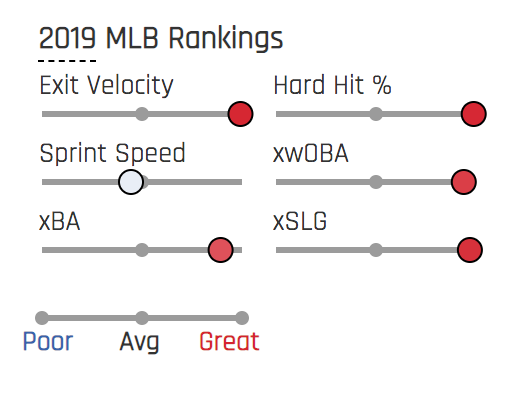
That’s a lot of red. More specifically: That’s a lot of red for metrics that may point to Walker’s hot start being legitimate. Had I come to Walker’s page and seen a blue circle where xBA is, I likely would’ve stopped digging. In this case, however, red means go. That much red means run the lights. It’s a driving metaphor.
Here are some of the other metrics I looked at and how Walker’s performance compares to the rest of the league:
| Metric | # | % of league |
| Avg Exit Velo | 95.9 | Top 1% |
| Hard Hit % | 61.2 | Top 1% |
| xBA | .305 | Top 10% |
| xSLG | .656 | Top 3% |
| wOBA | .469 | Top 3% |
| xWOBA | .427 | Top 6% |
| Brls/BBE% | 20.4 | Top 3% |
Once again, a lot of things stick out here:
- The xBA is about 40 points lower than his actual batting average, but the fact that it’s still over .300 means there’s some truth to what he is doing.
- The barrel rate is 6% higher than it was the previous year, so he’s either made some changes, is seeing the ball better, getting poor pitchers, something else entirely, or a mixture of all of the above.
- The hard-hit rate, barrel rate, and barrels per batted-ball event all support the fact that he’s hitting the cover off the ball.
- His xwOBA — which measures quality of contact and plate discipline — is alarming considering his strikeout rate and reputation for being a free-swinger.
- The average exit velocity is awe-inspiring, but is it because he’s just feasting on one part of the zone?
Excited about my findings, I took to Twitter. Pitcher List writer (and must-follow) Nick Gerli responded with this:
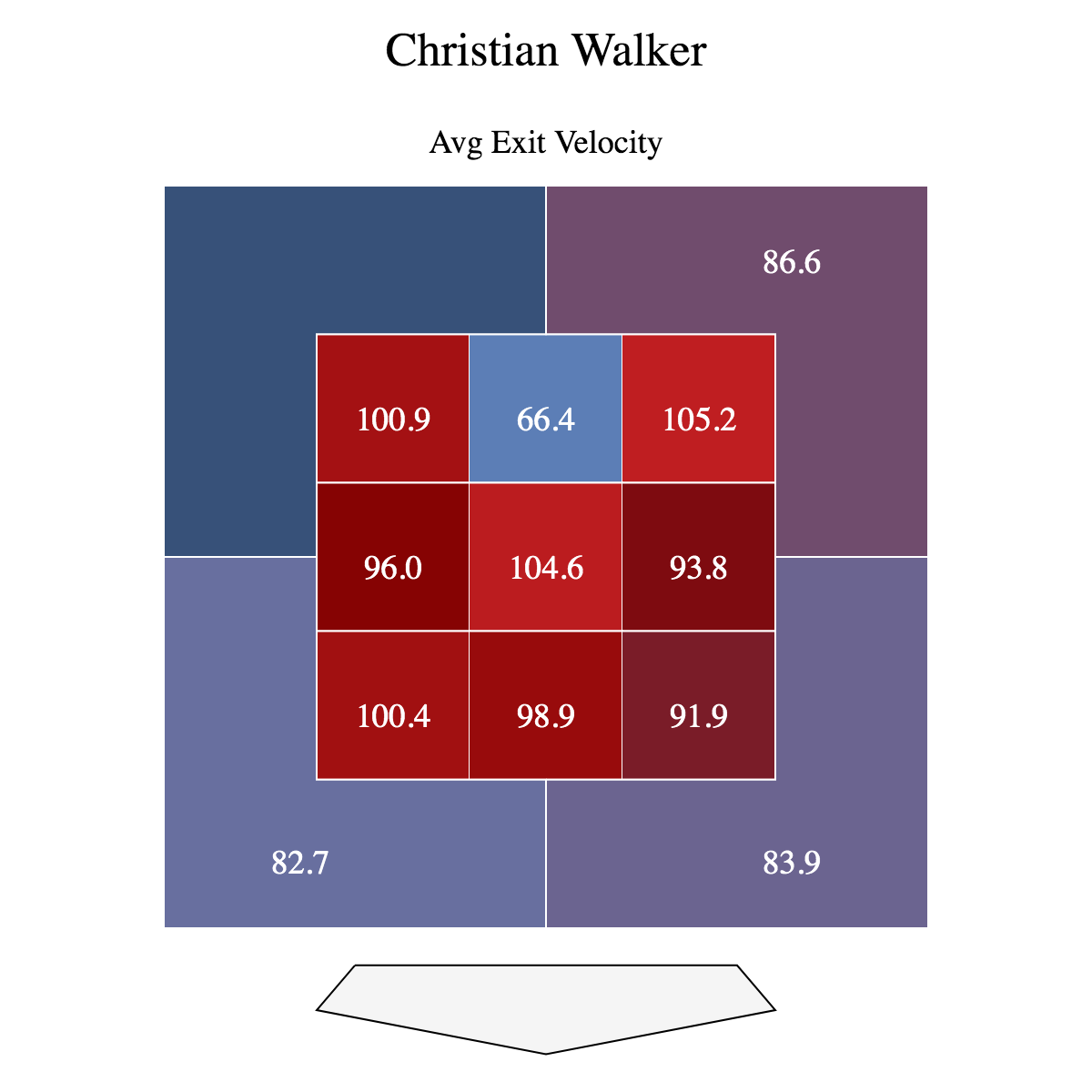
…
That’s fantastic plate coverage. Walker has an average exit velocity over 100 mph in almost 50% of the strike zone. While that abates my concern about his exit velocity, I’m still left to reconcile with how a guy who posted a 41.5% strikeout rate in 2018 is all of a sudden putting up a .427 xwOBA and a sub 30% strikeout rate.
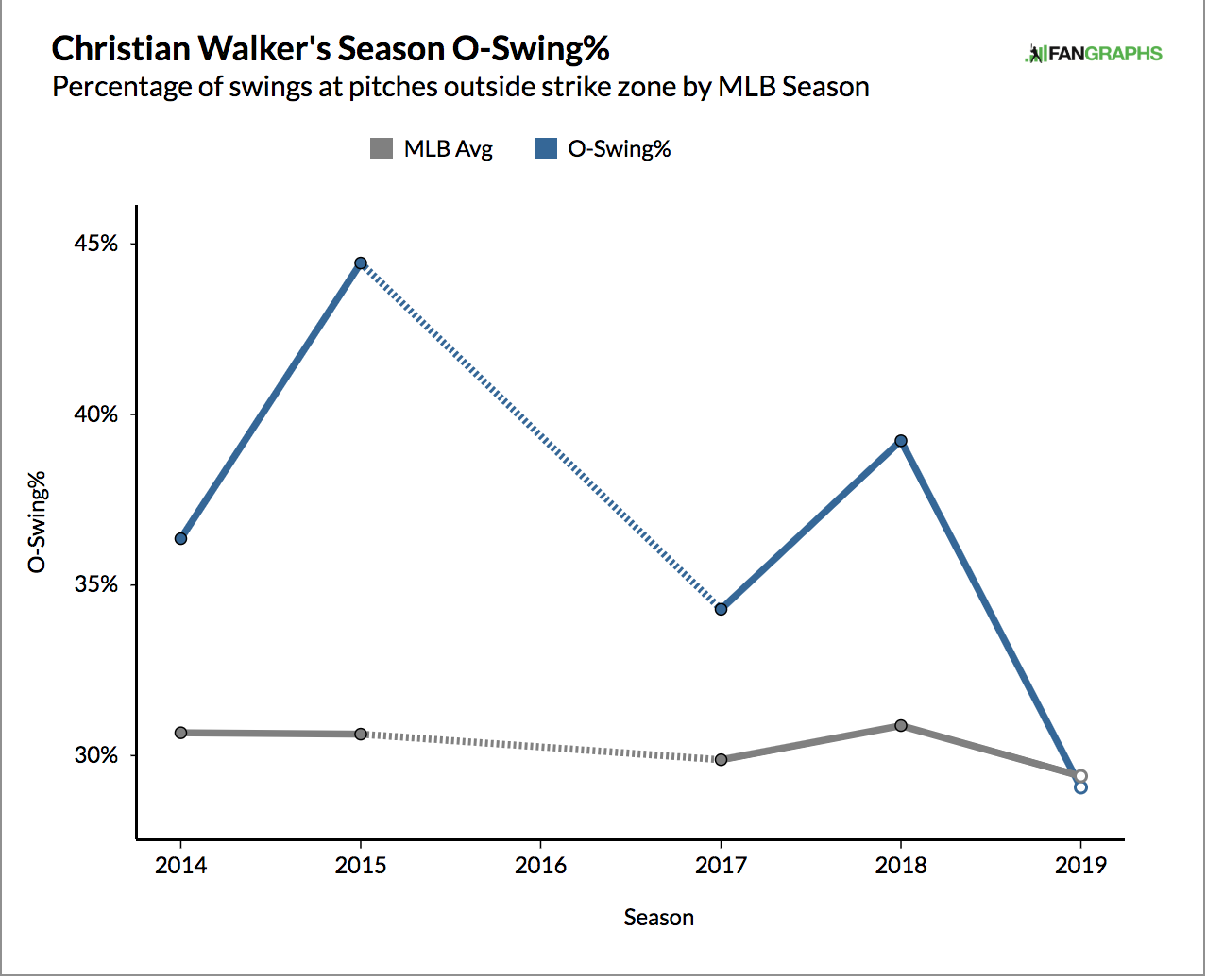
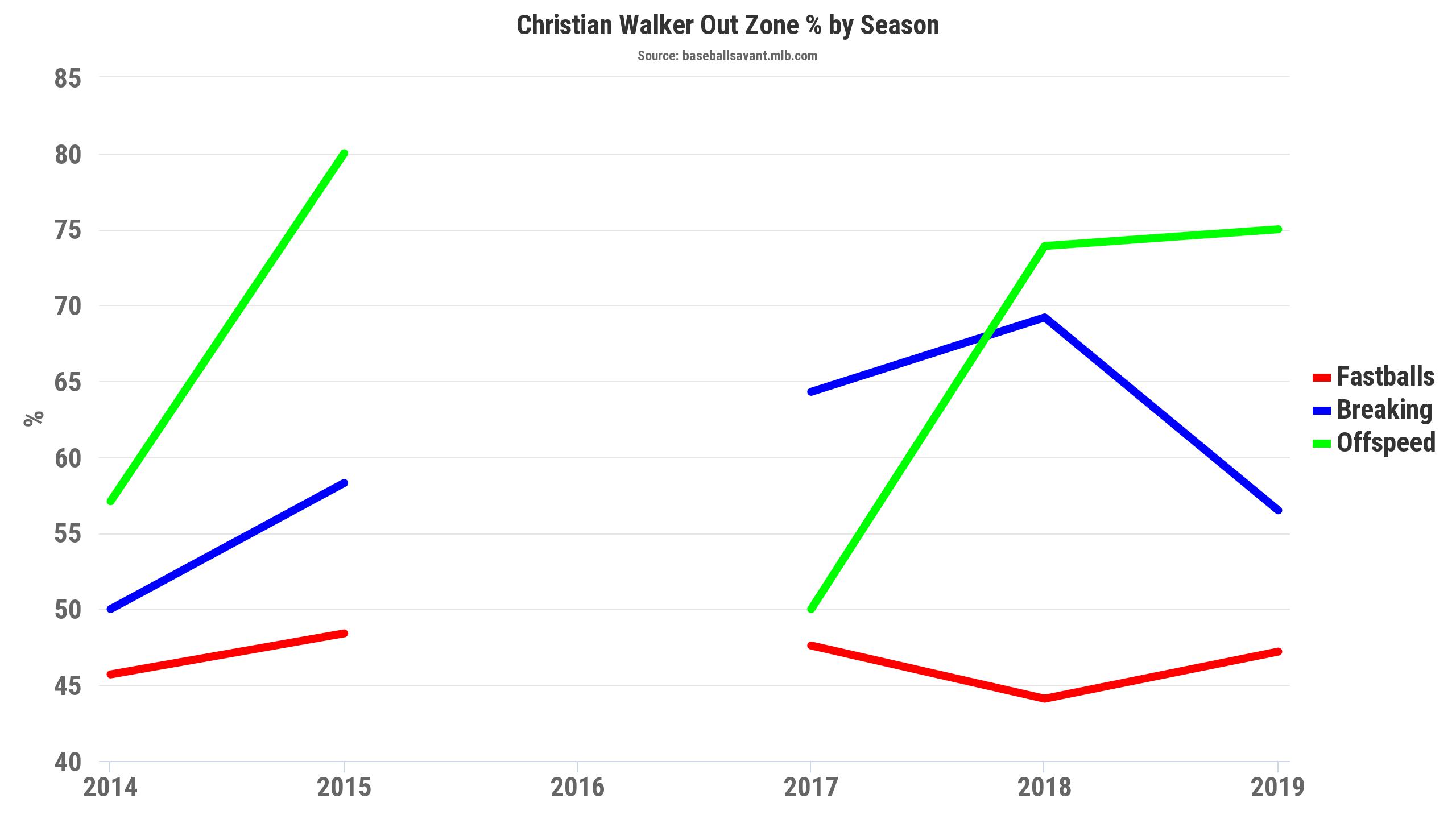
*Walker received fewer than 20 PA at the big league level in ’14, ’15 and ’17 so ignore those years.
Walker is swinging less outside of the zone at a 10% clip. While he’s still struggling against off-speed pitches — more on this later — he’s made considerable improvements against breaking pitches, specifically the slider. It isn’t for lack of trying on the pitchers behalf either:
| SL | 2018 | 2019 |
| % Thrown | 18.3% | 21.5% |
| BAA | .222 | .400 |
Walker has already seen more sliders than he saw in 2018, and he’s made vast improvements against the pitch. That’s not the only pitch he’s performing better against though. Walker has increased his hard-hit rate on every sort of pitch type:
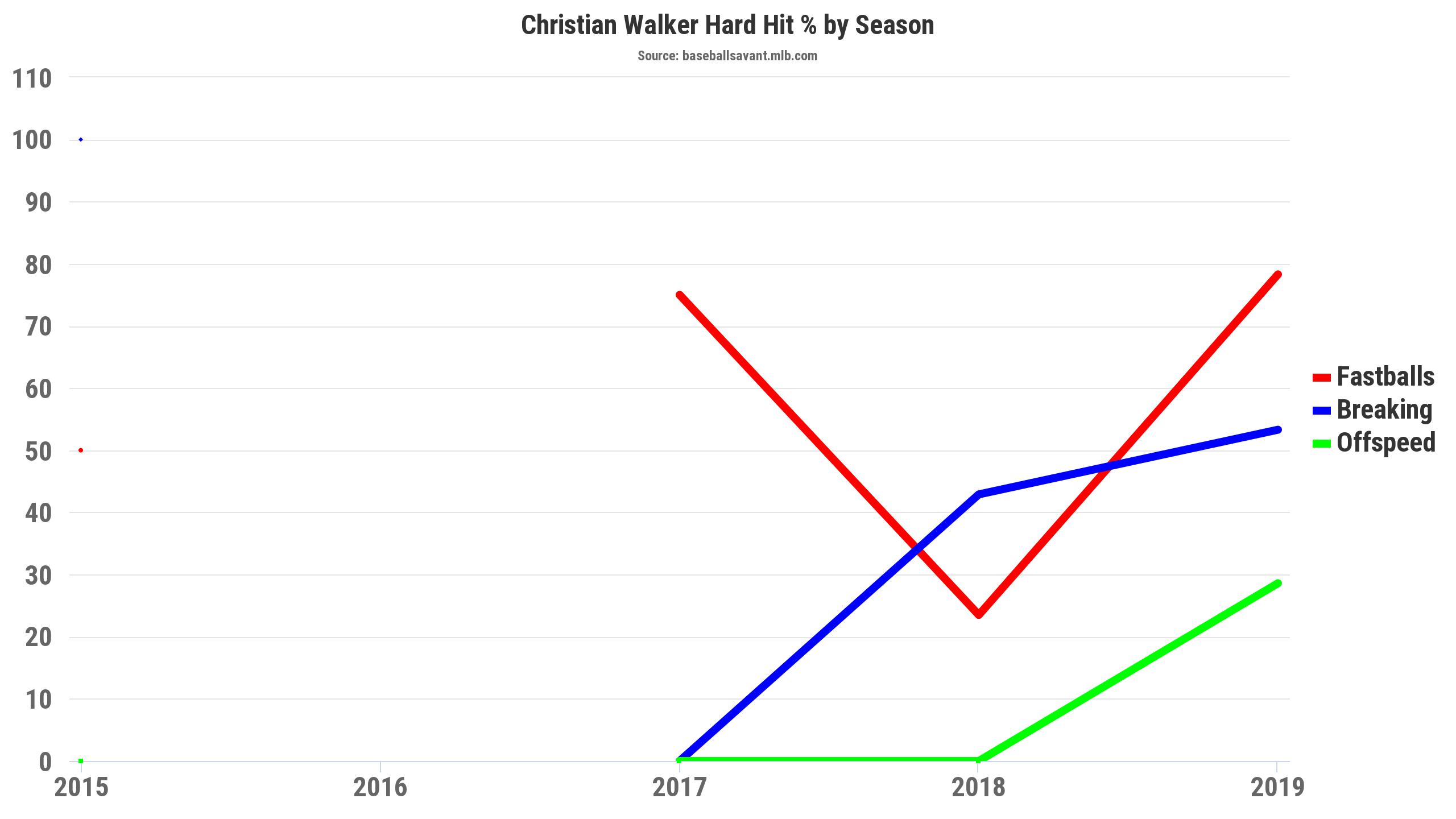
Full Contact
Usually when I see improvements in metrics like these, I’ll try to see if a hitter has changed something fundamentally. A change to a stance can often be a foundation upon which legitimate improvements are built. I took a look at Walker’s at-bats in20’18 and compared them with 2019 and found this:
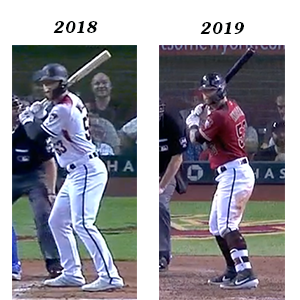
There’s a lot different here, so let’s break this down piece by piece. Let’s start with the feet. Walker has gone from his largely open stance in 2018 to a slightly open, almost square stance allowing his front side to be more square to the pitcher. His knees have a little bit less bend to them, creating more of an upright stance. His hands have moved closer to the body, and he’s neatened up a bit to create what I believe to be a quieter stance. I reached out to another fellow Pitcher List writer, Adam Garland, for what he thought about the change, and he had this to say:
“His new stance should allow him to stay back on that outside pitch better and keep the bat head in the hitting zone longer. The result should be more gap to gap power. Before, his hip and shoulder rotation may have been causing him to pull away from the pitch rather than drive into the pitch, so closing off a bit would help him stay more in line with the incoming pitch. It sort of reminds me of Giancarlo Stanton a couple years ago although definitely not as extreme. He’s probably realized that he doesn’t need to sell out for power to hit home runs, which has long been among his best assets at the plate, and he’s looking to make more contact instead but he’s still powerful enough to hit for power. By closing off his stance and staying back better, he’s improving his plate coverage, keeping his bat in the hitting zone longer and therefore making more contact.”
I’ve shown you from a metrics standpoint that the change in stance has led to success over a small sample size, but lets see it in action. Last year, not only did Walker go 0-7 on fastballs high and outside, he struck out in all seven of those instances at well. Here’s just one of those strikeouts:
To quote Garland once again: “You can see in the old stance that his hips fly open early as he begins to reach with his arms to get his bat head in the hitting zone and his upper body is dragging behind, and it’s just not a cohesive swing. He wasn’t going to do damage on that pitch even if he made contact with it.”
Now let’s take a look at that same pitch, with the same velocity, in that same location, in 2019:
Walker stays back longer, and his “hips are clearing at the right time. When coupled with the ‘lean back’ to aid in creating airborne contact, you can see why he’s able to do damage on that 96 mph fastball on the upper outside corner.”
Did I mention Garland knows what he’s talking about?
That pitch that Walker went 0-7 against last year? He’s 2-3 against it this year. Let me be perfectly clear here: That is the definition of a small sample size. This in no way, shape, or form means that Walker has mastered that part of the zone, nor does it provide concrete evidence that his change in stance led to him mastering that part of the zone.
However.
Before Walker was seeing every day playing time in the majors, he was a prospect in the BAL/ARI farm systems and was known for his power. In his last minor league stint in Triple-A, he slugged 32 homers. While that was in the PCL (a league notorious for its offensive output), he was putting up 18 and 20 home run seasons in Double-A for the Orioles as well. Not to mention his career average 19.3% barrel rate. With the changes Walker has made in his stance, he may be able to access that power without giving up on his ability to make contact.
Suspicious Minds
There are flaws. We’ve already mentioned Walker’s .409 BABIP, which is currently the fifth-highest in all of baseball. Walker is also hitting a poor .217 against left-handed pitchers, which could mean he could return to being the strong side of a platoon once the Diamondbacks get Jake Lamb back (Wilmer Flores would play first base). He’s still whiffing a ton and struggling mightily against offspeed pitches; he’s currently batting .100 against changeups. Some of these flaws may not be as bad as you think, though.
Let’s break down that BABIP by taking into consideration the tests set up by Chaz Steinberg in this fantastic reddit post and reiterated to me by Pitcher List writer Dave Cherman. Essentially, not all BABIPs are created equal. To get a better sense of whether a hitter has “earned” his BABIP, you want to see if he has:
- A low number of pop-ups.
- A low number of fly balls in general.
- More line drives.
- Pulling the ball less often.
- Sprint speed.
If a hitter can check off a few of those, the BABIP may not regress as severely as one would expect. So let’s see how Walker does in each of those tests:
| Metric | Walker | League Avg |
| IFFB% | 5.3 | 9.3% |
| FB% | 38.8 | 36.7% |
| LD% | 22.4 | 20.8% |
| Pull% | 40.8 | 41.6% |
| Sprint Speed (ft/s) | 26.6 | 27.0 |
Walker passes 3.5 out of the five tests. He has a below league average infield-fly rate, an above league average line-drive rate, and pulls the ball slightly less often. I’ll give him half a point for having a slightly higher FB rate than average, and he definitely doesn’t get a point for sprint speed. Yes, he’s close to league average, but Walker is not known for his speed. While not included in Steinberg’s test, I think it apt to mention that Walker’s xBACON (expected batting average on contact, takes home runs into account; broken down in this great piece by Dave Cherman) is an elite .590, further proving that it may have more substance than a typically elevated BABIP would.
This does not mean that Walker will not regress. His .409 BABIP is unsustainable. The good news, however, is his BABIP is not all smoke and mirrors. When the impending regression comes it may stabilize around .330 or .340, which would in theory make him a .270 hitter with above-average power.
What about those splits? Walker is slashing .217/.357/.435 against lefties. Once again though, I don’t think that is as bad as it looks as Walker has a xBA of .300 against lefties with an xSLG of .595. Gerli also brought to my attention that Walker actually didn’t platoon in the minors and for good reason. Here are his numbers against lefties in the minors for the past three seasons:
| Season | Org | Level | AB | AVG | OBP | SLG |
| 2016 | BAL | AAA | 102 | .265 | .348 | .441 |
| 2017 | ARI | AAA | 107 | .299 | .419 | .561 |
| 2018 | ARI | AAA | 86 | .337 | .368 | .558 |
As for the offspeed issues? They’re still there, and to be honest, they’re still a legitimate issue as is his whiff rate. While Walker has made strides in terms of his strikeout rate and brought his swinging-strike rate down a few ticks, he’s still sporting a near 40% swing-and-miss rate on offspeed pitches. I imagine the new stance will help stabilize this a little bit, but the fact remains it can still be an issue for him. If we see Walker plummet back down to his 2018 numbers — I don’t think we will — it will be because of his struggles against off-speed pitches.
The Final Showdown
So. Do you add Christian Walker? In short: Yes. He’s undeniably making great contact, he seems to have made legitimate changes to his stance that are resulting in his success, and he should be getting every day at-bats until the Diamondbacks get healthy again, at which point he still could be in the lineup each night. If Baseball Savant’s rolling expected wOBA is any indication, he shouldn’t really be cooling off any time soon:
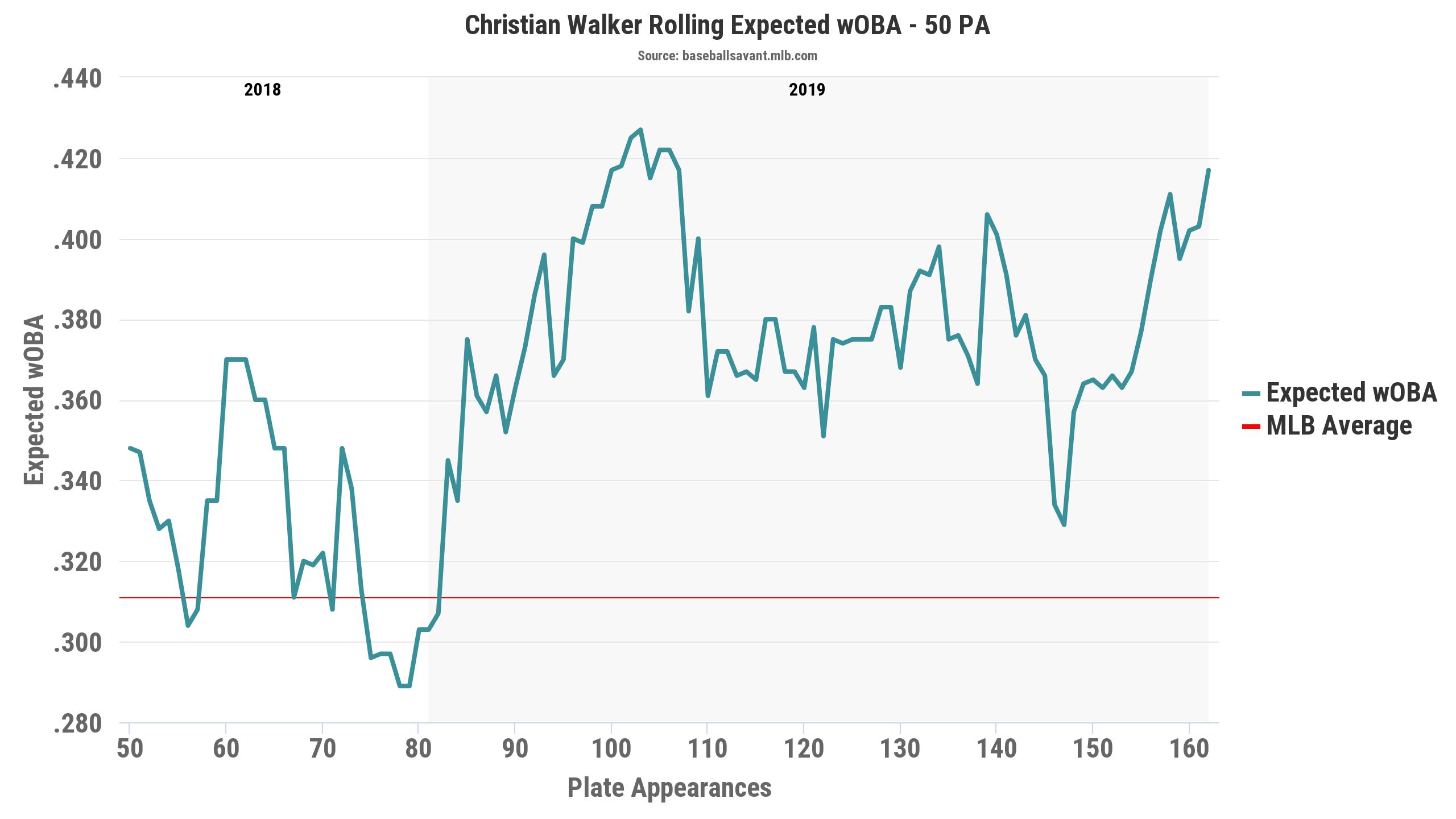
While his average is likely to regress and he’s certain to bring a fair amount of strikeouts to your lineup, he can still provide you with a .270-plus batting average in addition to 20-plus home runs, a pretty good value considering he’s currently available in 60% of leagues.
Is Christian Walker a “legitimate breakout”? That remains to be seen for certain. If he isn’t, you can likely release him back to the waiver with not much damage done and a few more home runs under your belt. If he is, wouldn’t you want to have him so your leaguemates don’t?
Illustration by Justin Paradis (@FreshMeatComm on Twitter)

A side-by-side of Walker and Smoak would be interesting. I would take Smoak. Peripherals are same and better in some categories than his 2017 year without the high K rate of Walker.
Excellent work, Alex! This was a fun read, i appreciated how you detailed your process of building a case for Walker.
Nice article! I watched Walker shine for the Reno Aces in person many times, including the year that he won PCL MVP. I am truly shocked it took this long for him to get every day at bats in the MLB (stuck in minors behind Chris Davis and Goldschmidt for years). Walker has always been able to hit great stuff. Prior to this year, he hit two massive home runs off Kershaw. For the Aces, I watched him hit a moonshot off Frankie Montas (SP for Athletics now) on a night where Montas was consistently throwing 100 mph+ and blowing others away. Walker is a legend for helping South Carolina win the College World Series twice, and he absolutely raked in the minors. Prior to this year, the majority of his MLB abs (less than 100 total) were spot starts or pinch hit appearances against set-up guys and closers. Hard to get a rhythm that way. My prediction for 2019 is .290 with 30 jacks.